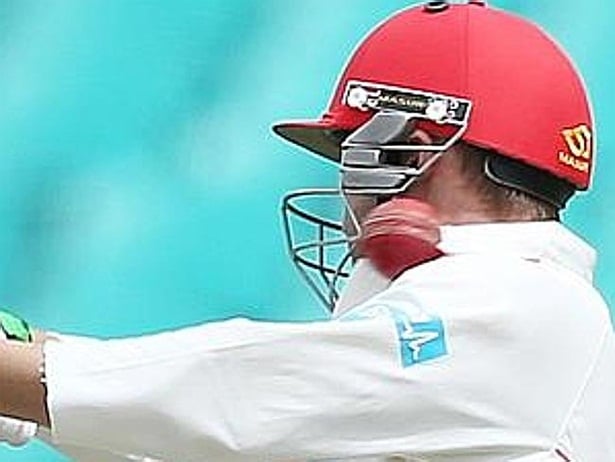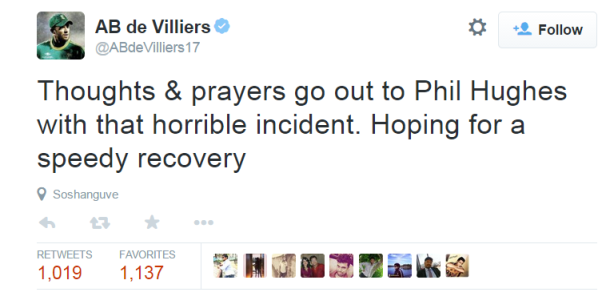
The moment that the ball hit his head blood started to build up around his brain and the injury was so traumatic that the emergency surgery that was performed on him could not save him.
According to Dr Tony Grabs, head of trauma at St Vincent's hospital where Phil died, the force with which the ball hit him caused a main artery to his brain to tear. This caused pressure on his brain and him to lose consciousness.
News.com.au reports that Hughes was turning his head at the moment the ball struck him, hitting him flush on the back of the head behind his left ear, narrowly missing the bottom of the rear of the helmet.
Sports doctor Dr Peter Larkins told the Herald Sun the precise area Hughes was hit is particularly vulnerable.
“The brain comes right down to the upper part of your neck, so when you get a fracture with bleeding underneath it can cause enormous pressure to build up in the spinal canal and go up into the brain,” Larkins said.
Swelling on the brain can cause blood vessels to become constricted restricting the vital flow of blood to the brain cells. In this case, cells don't receive the oxygen they need and cannot remove the toxic CO2, thus they die. The lower back of the neck is near where some of the most vital functions of the brain are housed, including respiration and heart rate. Any severe loss of function here is likely to result in death.
Below you can see the exact location of the blow
How can a cricket ball kill you?
Hughes was hit by a bouncer, a short pitched delivery that bounces high and is often aimed at the batsman's head or neck area. The bowling of a bouncer is very common, and rarely results in the batsman being struck as they simply duck or hit the ball.
The impact of the blow caused Hughes to collapse, hitting the ground face first. A medical team worked on giving him mouth-mouth resuscitation for half an hour before Hughes was airlifted to St Vincent's hospital in Sydney on life support, Sky News stated. Hughes underwent emergency surgery which he survived, and was then placed in an induced coma to reduce swelling in the brain.
Read: Schumacher: what is an induced coma?
Questions were raised about the delay in the ambulance arriving at the scene as it took 23 minutes for the ambulance to arrive, despite the fact that the SCG is located in central Sydney, Australia's biggest city and an ambulance was just 800 metres away at the time of the blow.
The New South Whales Ambulance Service admitted that an ambulance was only dispatched after a second call was made, according to TVNZ. A fast response is crucial to the patient's survival when dealing with brain injuries, especially where bleeding or swelling is present.
To see how the injury occurred, take a look at this video clip of the game:
Video courtesy of The Starters on YouTube
Head injuries in cricket
Head injuries used to be more common among cricketers before helmets were commonly used, and are especially common among young players. This type of injury is usually the result of a blow to the face from a ball travelling at a high speed. The nose, teeth and jaw can suffer severe fractures, open wounds and bruising in this way.
As in rugby and soccer, concussion can occur. Symptoms include amnesia, memory loss, headache, confusion, poor coordination or vision disturbances. Players who have suffered concussion do not necessarily lose consciousness.
Other well known head injuries in cricket include that of former West Indies batsmen, Phillip Simmons who was struck by a fast ball in a test match against Gloucestershire in Bristol, England in 1988. Simmons' heart stopped but he managed to make a full recovery after extensive surgery to the brain, according to an article by the Sydney Morning Herald.
Injuries to the cerebellum
The neck is also where all of the brain's blood flows through, and given the location of the blow, it could have impacted blood flow to the cerebellum. The cerebellum is part of the brain that is responsible for balance, movement, coordination and posture. It is also responsible for speech. While the cerebellum is a relatively small area of the brain, it actually contains approximately 50% of the brain's neurons.
Support for Hughes
Globally, both the cricket community and the public showed a tremendous amount of support for Hughes. Australian Test Captain Michael Clark kept vigil at Hughes' bedside throughout. Locally, Cricket South Africa, Jacques Kallis and AB de Villiers are amongst those who tweeted messages of support.



After the news broke, these message of support took a sombre turn. Tributes to the fallen cricketer have been flooding in since the news broke, with even the Prime Minister of Australia calling a press conference to offer his condolences.
Woken to the horrific news about Hughesy ! I cannot describe the sadness I feel for the Hughes family & fellow cricket players, so so sad
— Shane Warne (@ShaneWarne) November 27, 2014That ball could have been bowled at any time in any game. Tragic that it should end like this for the Hughes family, and for Sean Abbott
— Jonathan Agnew (@Aggerscricket) November 27, 2014"Bowler Sean Abbott leaves hospital after the passing of Phillip Hughes http://t.co/OyFlx21TCe pic.twitter.com/Wljt8xjoiH"
— Rob Louw (@roblouw6) November 27, 2014Read more:
Duminy's knee injury: what you should know
Danger zones on the cricket field
Shumi: How a brain injury could affect you




 Publications
Publications
 Partners
Partners










